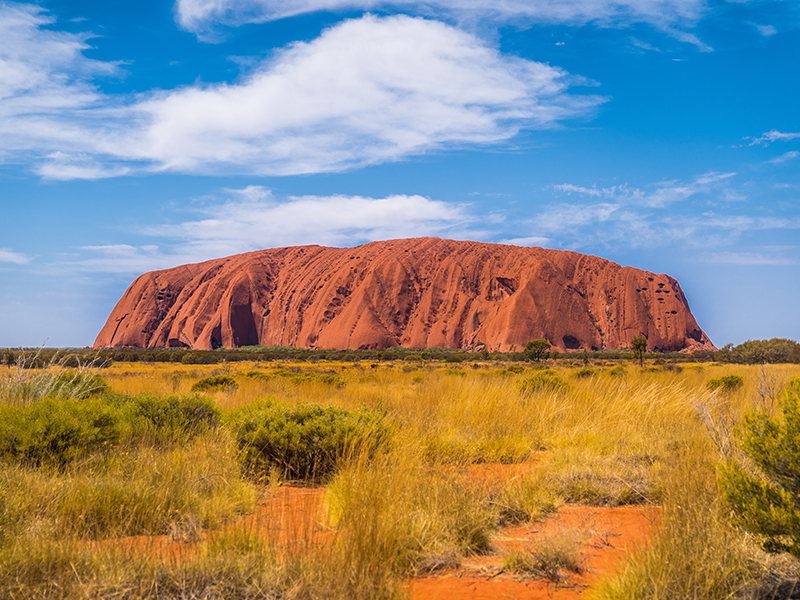Uluru holds immense cultural significance for the Anangu people, the land’s traditional custodians. For thousands of years, it has been a sacred site and a central part of Anangu’s spiritual and cultural practices. The rock’s numerous caves and crevices are adorned with ancient rock art, depicting stories and events integral to the Anangu’s Tjukurpa, or Dreamtime, their creation mythology and spiritual law.
European explorers first sighted Uluru in the 1870s, and it was named Ayers Rock after Sir Henry Ayers, the then Chief Secretary of South Australia. In 1985, the Australian government returned the ownership of Uluru to the Anangu people, and it was officially renamed Uluru/Ayers Rock. The Anangu now co-manages the Uluru-Kata Tjuta National Park in collaboration with the government.
The Mala story is a significant creation story of the Anangu people, the traditional custodians of Uluru. According to the tale, a group of Mala (rufous hare-wallaby) people journeyed from the north to reach Uluru, where they planned to hold an important ceremony. As they arrived, they set up their ceremonial ground and began preparations. Meanwhile, another group of Mala from the west invited them to a separate ceremony, but the Uluru Mala declined, wishing to complete their own ritual first. This decision led to tension between the groups.
In response to the rejection, the western Mala sent a malevolent spirit, Kurpany, to disrupt the Uluru ceremony. Kurpany transformed into a ferocious dog-like creature and wreaked havoc upon the Mala people at Uluru, causing chaos and fear. The Mala tried to fight off Kurpany, but many were killed or forced to flee. The story of the Mala and Kurpany is etched into the landscape of Uluru through various rock formations and markings, serving as a reminder of the Mala people’s cultural heritage and the importance of respecting traditional laws and customs.
The Australian government has taken significant steps to protect and preserve Uluru in collaboration with the Anangu people. Uluru-Kata Tjuta National Park is a UNESCO World Heritage Site recognised for its natural and cultural values. This designation helps ensure the park receives international attention and resources for its preservation.
Several initiatives are in place to manage tourism’s environmental and cultural impact. These include:
- Visitor Education: Informative programs and displays educate visitors about Uluru’s cultural significance and the importance of respecting Anangu traditions and the land.
- Environmental Management: Ongoing conservation efforts focus on protecting the natural landscape and biodiversity of the park. This includes controlling invasive species, managing water resources, and maintaining the natural habitats of native wildlife.
- Cultural Respect: The climbing ban and other measures aim to respect the cultural heritage of the Anangu people. Visitors are encouraged to engage with Anangu-guided tours and experiences to understand the area’s cultural significance better.
- Sustainable Tourism: The park promotes sustainable tourism practices to minimise visitors’ ecological footprints. Facilities and services are designed to be environmentally friendly and to support the local community.
- Colour Changes: Uluru is famous for its striking colour changes throughout the day, especially at sunrise and sunset. This phenomenon is due to the iron content in the rock, which rusts and changes colour when exposed to different light conditions.
- Geological Age: Uluru is estimated to be around 550 million years old. It was originally part of the ocean floor and has since been uplifted by geological forces.
- Climbing Ban: Climbing Uluru was officially banned on October 26, 2019, out of respect for its cultural significance to the Anangu people. Before the ban, many visitors climbed the rock, but the Anangu always asked visitors to respect their traditions and not climb.
- Biodiversity: Despite the harsh desert environment, Uluru-Kata Tjuta National Park is home to a surprising variety of flora and fauna. Visitors can find unique species of plants, mammals, birds, and reptiles adapted to the arid conditions.
Uluru is not just a stunning natural wonder; it is a sacred site that embodies the rich cultural heritage of the Anangu people. Through careful management and respect for its artistic and environmental significance, Uluru will continue to awe and inspire future generations. Whether you marvel at its breathtaking colour changes or learn about its ancient stories, visiting Uluru is a journey into the heart of Australia’s natural and cultural history.
















